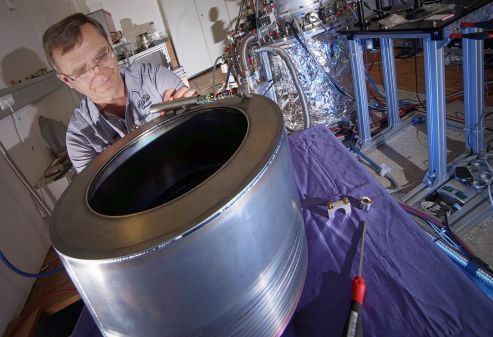A Cryogenic Current Comparator
Collaborators:
Thomas Stöhlker1,2,4 ,Volker Tympel2, Max Stapelfeld3, Frank Schmidl3, Paul Seidel3, Thomas Sieber4, Marcus Schwickert4, David Haider4, Matthias Schmelz5, Ronny Stolz5, Vyacheslav Zakosarenko5,6, Herbert De Gersem7, Nicolas Marsic7, Wolfgang F.O. Müller7 and Jocelyn Tan8
1Institute of Optics and Quantum Electronics, Friedrich Schiller University Jena
2Helmholtz Institute JenaExternal link
3Institute of Solid State Physics, Friedrich Schiller University Jena
4GSI Helmholtzzentrum für Schwerionenforschung GmbHExternal link
5Leibniz Institute of Photonic Technology e.V. (Leibniz IPHT), JenaExternal link
6Supracon AG, JenaExternal link
7TU DarmstadtExternal link
8CERN, GenfExternal link
One solution to this problem is to detect the magnetic field generated by the moving charged particles. In a project with the Institute for Solid State Physics at the Friedrich Schiller University Jena, the Helmholtz Institute Jena and the GSI's radiation diagnosis group, a non-destructive beam monitoring system for particle beams in accelerators based on the cryogenic current comparator principle (CCC) was developed and optimized [1]. The CCC consists of a superconducting low-temperature DC quantum interference detector (SQUID), a superconducting ring-shaped pickup coil and a highly effective meander-shaped superconducting shield. This device enables the measurement of continuous (DC) and pulsed beam currents in the nA range. A niobium CCC from Jena is currently in use at the CERN Antiproton Decelerator (AD)External link to measure antiproton currents.
CCC collaboration in the CERN-AD control room, the current measured values of the CERN-Nb-CCC are displayed on a monitor in the control room.
Image: Volker TympelSeveral CCC installations are planned for the international FAIR projectExternal link in Darmstadt, whereby larger CCC inner diameters (XD series) are required for 150 mm radiant tubes. The testing of different CCC-XDs (Nb-classic, Pb-coreless, Pb-Dual-CCC) will take place in Darmstadt at the CRYRING@ESRExternal link.
Engineer Ralf Neubert (formerly IFK) assembling the FAIR-Nb-CCC-XD for a 150 mm nozzle diameter of the FAIR project
Image: Jan-Peter Kasper (University of Jena)

